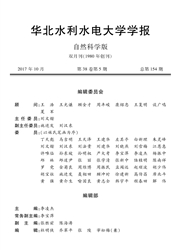

 中文摘要:
中文摘要:
对引汉济渭工程关中受水区22个供水单元划分了4类供水对象,在考虑经济社会发展和生态保护的基础上,设置了2030规划水平年水量配置的6个方案;分别建立了水量平衡模型、需水模型、供水保障率模型、供需平衡模型、多因子综合模型、融合赋权的水资源可持续发展战略模型等6种模型,进行水量配置研究;并在水量配置方案结果的基础上,引入破产理论中的资源配置稳定性指标和改进的评价跨流域水资源配置冲突解决稳定性指标,对方案进行稳定性评价。结果表明,考虑供需平衡的方案4的水量配置结果较其他方案的结果更为稳定。研究成果可为关中地区经济、社会的可持续发展和生态环境的良性循环提供科学依据,同时发展了水资源配置的理论和方法。
 英文摘要:
英文摘要:
In this paper, 22 water supply units of water imported areas in the central Shaanxi plain in Hanjiang to Weihe Water Trans- fer Engineering, were classified into four types of water supply objects, and based on the consideration of the economic-social develop- ment and ecological protection, six schemes of water allocation in the planning level year of 2030 were set up; six models were applied to investigate the water allocation, and the six models were the models of water balance, water demand, water supply rate, balance be- tween supply and demand, muhi-faetor comprehensiveness and empowerment sustainable development strategy; On the basis of the re- sults of water allocation schemes, the resource allocation stability index in bankruptcy theory and the improved index of evaluating the conflict resolution stability of inter-basin water allocation were introduced to evaluate the stability of schemes. The results show that the result of water allocation is steadiest in the scheme 4 which has considered the balance between supply and demand. The research re- suits can provide scientific basis for economic-social sustainable development and ecological environment benign circulation of the cen- tral Shaanxi plain, and develop the theory and allocation methods of water resources.
 同期刊论文项目
同期刊论文项目
 同项目期刊论文
同项目期刊论文
 期刊信息
期刊信息
